BMW X5 4.8IS 2004 E53 Repair Manual
Manufacturer: BMW, Model Year: 2004, Model line: X5 4.8IS, Model: BMW X5 4.8IS 2004 E53Pages: 200, PDF Size: 3.91 MB
Page 61 of 200
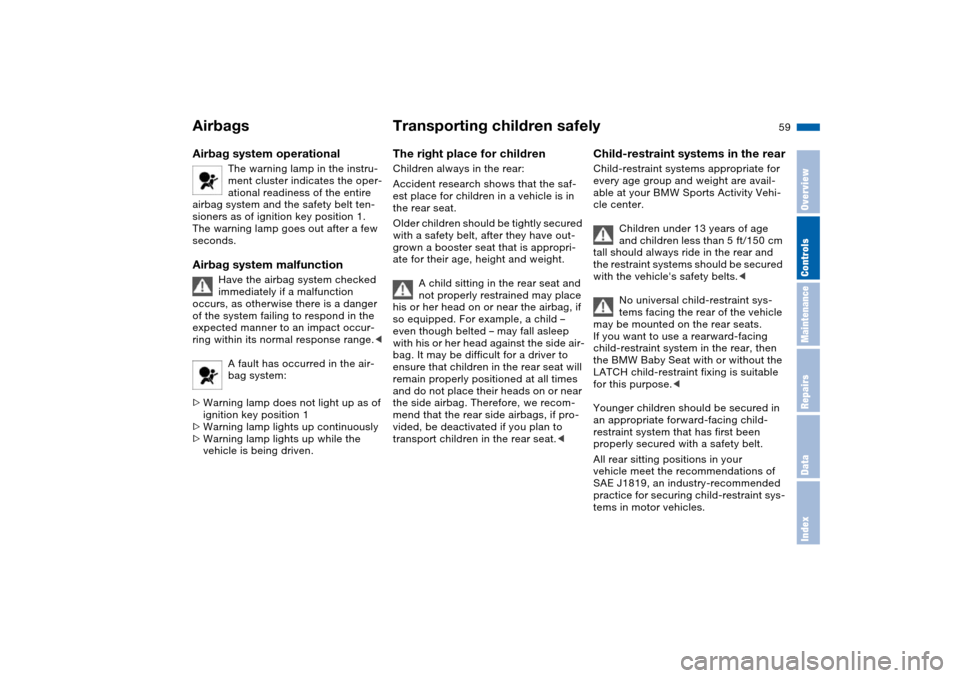
59n
OverviewControlsMaintenanceRepairsDataIndex
Airbags Transporting children safely Airbag system operational
The warning lamp in the instru-
ment cluster indicates the oper-
ational readiness of the entire
airbag system and the safety belt ten-
sioners as of ignition key position 1.
The warning lamp goes out after a few
seconds.
Airbag system malfunction
Have the airbag system checked
immediately if a malfunction
occurs, as otherwise there is a danger
of the system failing to respond in the
expected manner to an impact occur-
ring within its normal response range.<
A fault has occurred in the air-
bag system:
>Warning lamp does not light up as of
ignition key position 1
>Warning lamp lights up continuously
>Warning lamp lights up while the
vehicle is being driven.
The right place for children Children always in the rear:
Accident research shows that the saf-
est place for children in a vehicle is in
the rear seat.
Older children should be tightly secured
with a safety belt, after they have out-
grown a booster seat that is appropri-
ate for their age, height and weight.
A child sitting in the rear seat and
not properly restrained may place
his or her head on or near the airbag, if
so equipped. For example, a child –
even though belted – may fall asleep
with his or her head against the side air-
bag. It may be difficult for a driver to
ensure that children in the rear seat will
remain properly positioned at all times
and do not place their heads on or near
the side airbag. Therefore, we recom-
mend that the rear side airbags, if pro-
vided, be deactivated if you plan to
transport children in the rear seat.<
Child-restraint systems in the rearChild-restraint systems appropriate for
every age group and weight are avail-
able at your BMW Sports Activity Vehi-
cle center.
Children under 13 years of age
and children less than 5 ft/150 cm
tall should always ride in the rear and
the restraint systems should be secured
with the vehicle's safety belts.<
No universal child-restraint sys-
tems facing the rear of the vehicle
may be mounted on the rear seats.
If you want to use a rearward-facing
child-restraint system in the rear, then
the BMW Baby Seat with or without the
LATCH child-restraint fixing is suitable
for this purpose.<
Younger children should be secured in
an appropriate forward-facing child-
restraint system that has first been
properly secured with a safety belt.
All rear sitting positions in your
vehicle meet the recommendations of
SAE J1819, an industry-recommended
practice for securing child-restraint sys-
tems in motor vehicles.
Page 62 of 200
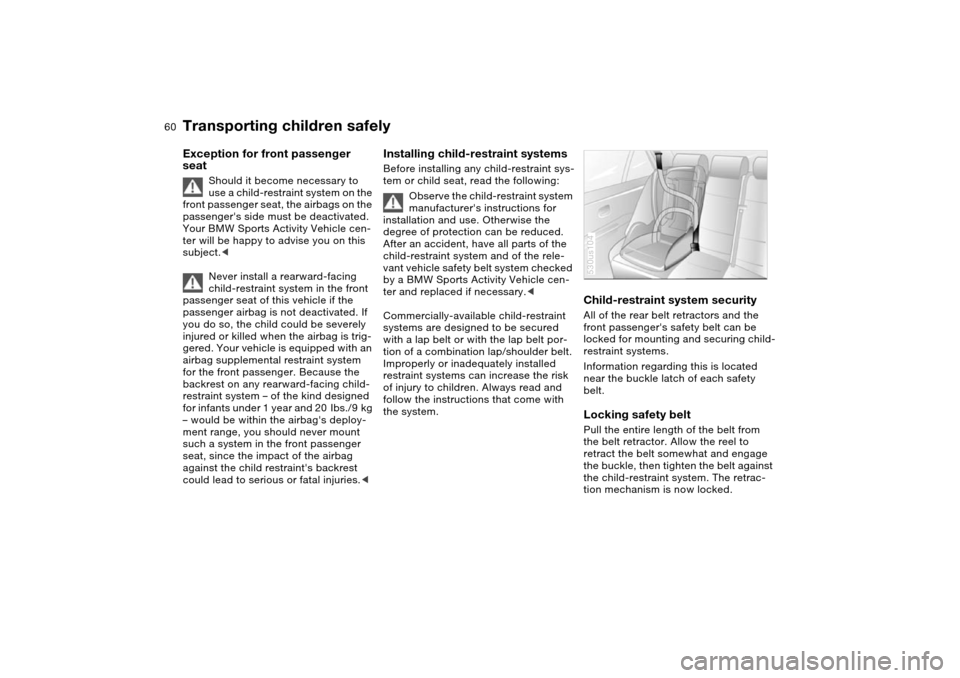
60n
Transporting children safelyException for front passenger
seat
Should it become necessary to
use a child-restraint system on the
front passenger seat, the airbags on the
passenger's side must be deactivated.
Your BMW Sports Activity Vehicle cen-
ter will be happy to advise you on this
subject.<
Never install a rearward-facing
child-restraint system in the front
passenger seat of this vehicle if the
passenger airbag is not deactivated. If
you do so, the child could be severely
injured or killed when the airbag is trig-
gered. Your vehicle is equipped with an
airbag supplemental restraint system
for the front passenger. Because the
backrest on any rearward-facing child-
restraint system – of the kind designed
for infants under 1 year and 20 Ibs./9 kg
– would be within the airbag's deploy-
ment range, you should never mount
such a system in the front passenger
seat, since the impact of the airbag
against the child restraint's backrest
could lead to serious or fatal injuries.<
Installing child-restraint systemsBefore installing any child-restraint sys-
tem or child seat, read the following:
Observe the child-restraint system
manufacturer's instructions for
installation and use. Otherwise the
degree of protection can be reduced.
After an accident, have all parts of the
child-restraint system and of the rele-
vant vehicle safety belt system checked
by a BMW Sports Activity Vehicle cen-
ter and replaced if necessary.<
Commercially-available child-restraint
systems are designed to be secured
with a lap belt or with the lap belt por-
tion of a combination lap/shoulder belt.
Improperly or inadequately installed
restraint systems can increase the risk
of injury to children. Always read and
follow the instructions that come with
the system.
Child-restraint system securityAll of the rear belt retractors and the
front passenger's safety belt can be
locked for mounting and securing child-
restraint systems.
Information regarding this is located
near the buckle latch of each safety
belt. Locking safety belt Pull the entire length of the belt from
the belt retractor. Allow the reel to
retract the belt somewhat and engage
the buckle, then tighten the belt against
the child-restraint system. The retrac-
tion mechanism is now locked. 530us104
Page 63 of 200
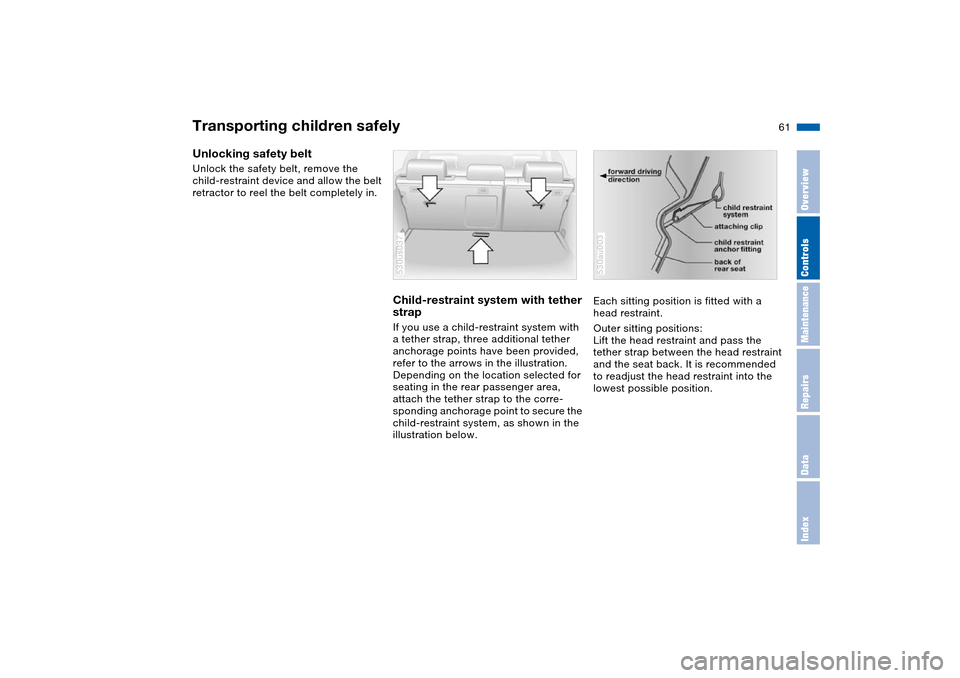
61n
OverviewControlsMaintenanceRepairsDataIndex
Transporting children safelyUnlocking safety belt Unlock the safety belt, remove the
child-restraint device and allow the belt
retractor to reel the belt completely in.
Child-restraint system with tether
strapIf you use a child-restraint system with
a tether strap, three additional tether
anchorage points have been provided,
refer to the arrows in the illustration.
Depending on the location selected for
seating in the rear passenger area,
attach the tether strap to the corre-
sponding anchorage point to secure the
child-restraint system, as shown in the
illustration below. 530us037
Each sitting position is fitted with a
head restraint.
Outer sitting positions:
Lift the head restraint and pass the
tether strap between the head restraint
and the seat back. It is recommended
to readjust the head restraint into the
lowest possible position.530au003
Page 64 of 200
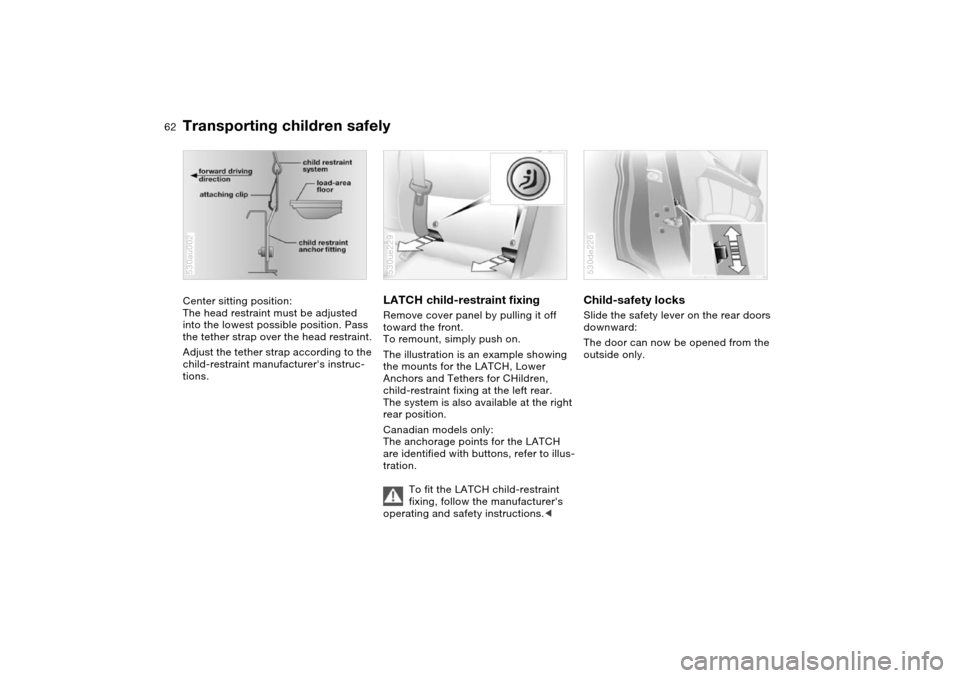
62n
Transporting children safelyCenter sitting position:
The head restraint must be adjusted
into the lowest possible position. Pass
the tether strap over the head restraint.
Adjust the tether strap according to the
child-restraint manufacturer's instruc-
tions.530au002
LATCH child-restraint fixing Remove cover panel by pulling it off
toward the front.
To remount, simply push on.
The illustration is an example showing
the mounts for the LATCH, Lower
Anchors and Tethers for CHildren,
child-restraint fixing at the left rear.
The system is also available at the right
rear position.
Canadian models only:
The anchorage points for the LATCH
are identified with buttons, refer to illus-
tration.
To fit the LATCH child-restraint
fixing, follow the manufacturer's
operating and safety instructions.<530ue229
Child-safety locks Slide the safety lever on the rear doors
downward:
The door can now be opened from the
outside only. 530de226
Page 65 of 200
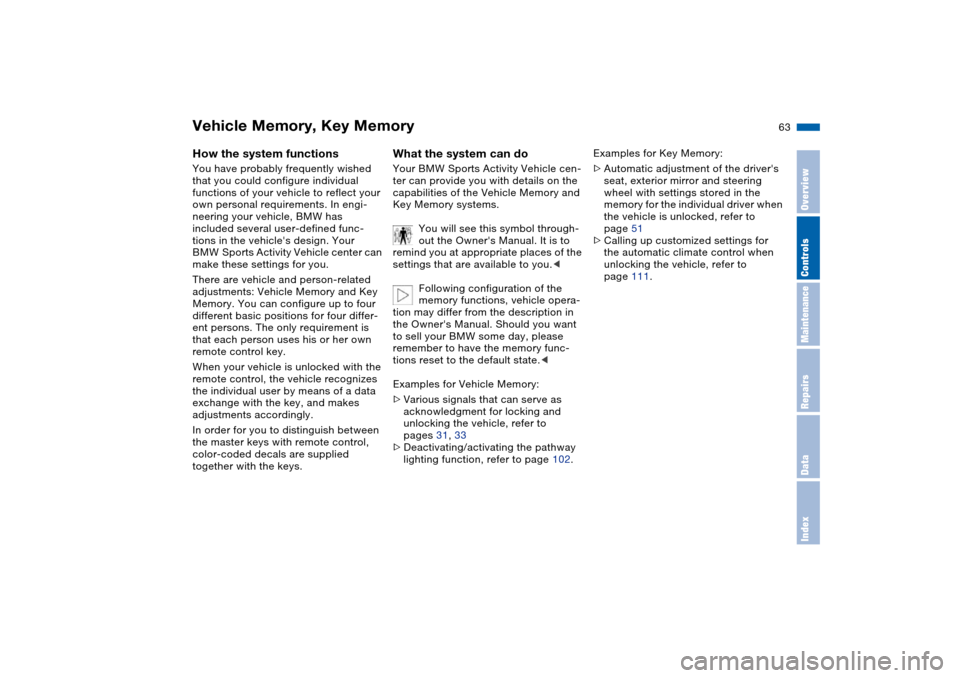
63n
OverviewControlsMaintenanceRepairsDataIndex
Vehicle Memory, Key Memory How the system functions You have probably frequently wished
that you could configure individual
functions of your vehicle to reflect your
own personal requirements. In engi-
neering your vehicle, BMW has
included several user-defined func-
tions in the vehicle's design. Your
BMW Sports Activity Vehicle center can
make these settings for you.
There are vehicle and person-related
adjustments: Vehicle Memory and Key
Memory. You can configure up to four
different basic positions for four differ-
ent persons. The only requirement is
that each person uses his or her own
remote control key.
When your vehicle is unlocked with the
remote control, the vehicle recognizes
the individual user by means of a data
exchange with the key, and makes
adjustments accordingly.
In order for you to distinguish between
the master keys with remote control,
color-coded decals are supplied
together with the keys.
What the system can doYour BMW Sports Activity Vehicle cen-
ter can provide you with details on the
capabilities of the Vehicle Memory and
Key Memory systems.
You will see this symbol through-
out the Owner's Manual. It is to
remind you at appropriate places of the
settings that are available to you.<
Following configuration of the
memory functions, vehicle opera-
tion may differ from the description in
the Owner's Manual. Should you want
to sell your BMW some day, please
remember to have the memory func-
tions reset to the default state.<
Examples for Vehicle Memory:
>Various signals that can serve as
acknowledgment for locking and
unlocking the vehicle, refer to
pages 31, 33
>Deactivating/activating the pathway
lighting function, refer to page 102.
Examples for Key Memory:
>Automatic adjustment of the driver's
seat, exterior mirror and steering
wheel with settings stored in the
memory for the individual driver when
the vehicle is unlocked, refer to
page 51
>Calling up customized settings for
the automatic climate control when
unlocking the vehicle, refer to
page 111.
Page 66 of 200
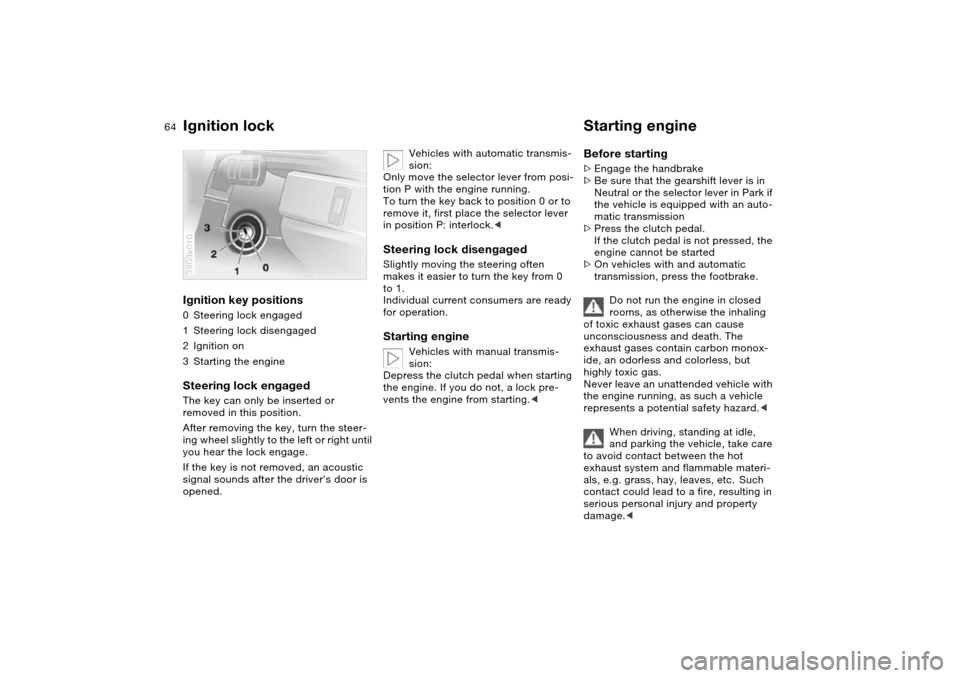
64n
Ignition lock Starting engine Ignition key positions 0Steering lock engaged
1Steering lock disengaged
2Ignition on
3Starting the engineSteering lock engaged The key can only be inserted or
removed in this position.
After removing the key, turn the steer-
ing wheel slightly to the left or right until
you hear the lock engage.
If the key is not removed, an acoustic
signal sounds after the driver's door is
opened.390de010
Vehicles with automatic transmis-
sion:
Only move the selector lever from posi-
tion P with the engine running.
To turn the key back to position 0 or to
remove it, first place the selector lever
in position P: interlock.<
Steering lock disengaged Slightly moving the steering often
makes it easier to turn the key from 0
to 1.
Individual current consumers are ready
for operation. Starting engine
Vehicles with manual transmis-
sion:
Depress the clutch pedal when starting
the engine. If you do not, a lock pre-
vents the engine from starting.<
Before starting >Engage the handbrake
>Be sure that the gearshift lever is in
Neutral or the selector lever in Park if
the vehicle is equipped with an auto-
matic transmission
>Press the clutch pedal.
If the clutch pedal is not pressed, the
engine cannot be started
>On vehicles with and automatic
transmission, press the footbrake.
Do not run the engine in closed
rooms, as otherwise the inhaling
of toxic exhaust gases can cause
unconsciousness and death. The
exhaust gases contain carbon monox-
ide, an odorless and colorless, but
highly toxic gas.
Never leave an unattended vehicle with
the engine running, as such a vehicle
represents a potential safety hazard.<
When driving, standing at idle,
and parking the vehicle, take care
to avoid contact between the hot
exhaust system and flammable materi-
als, e.g. grass, hay, leaves, etc. Such
contact could lead to a fire, resulting in
serious personal injury and property
damage.<
Page 67 of 200
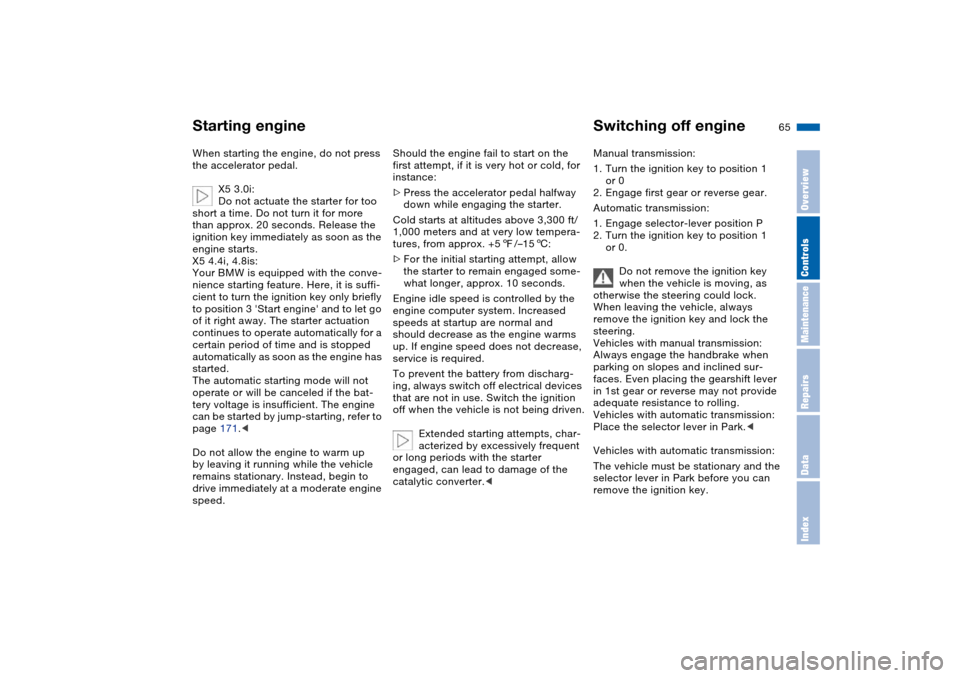
65n
OverviewControlsMaintenanceRepairsDataIndex
Starting engine Switching off engineWhen starting the engine, do not press
the accelerator pedal.
X5 3.0i:
Do not actuate the starter for too
short a time. Do not turn it for more
than approx. 20 seconds. Release the
ignition key immediately as soon as the
engine starts.
X5 4.4i, 4.8is:
Your BMW is equipped with the conve-
nience starting feature. Here, it is suffi-
cient to turn the ignition key only briefly
to position 3 'Start engine' and to let go
of it right away. The starter actuation
continues to operate automatically for a
certain period of time and is stopped
automatically as soon as the engine has
started.
The automatic starting mode will not
operate or will be canceled if the bat-
tery voltage is insufficient. The engine
can be started by jump-starting, refer to
page 171.<
Do not allow the engine to warm up
by leaving it running while the vehicle
remains stationary. Instead, begin to
drive immediately at a moderate engine
speed.
Should the engine fail to start on the
first attempt, if it is very hot or cold, for
instance:
>Press the accelerator pedal halfway
down while engaging the starter.
Cold starts at altitudes above 3,300 ft/
1,000 meters and at very low tempera-
tures, from approx. +57/–156:
>For the initial starting attempt, allow
the starter to remain engaged some-
what longer, approx. 10 seconds.
Engine idle speed is controlled by the
engine computer system. Increased
speeds at startup are normal and
should decrease as the engine warms
up. If engine speed does not decrease,
service is required.
To prevent the battery from discharg-
ing, always switch off electrical devices
that are not in use. Switch the ignition
off when the vehicle is not being driven.
Extended starting attempts, char-
acterized by excessively frequent
or long periods with the starter
engaged, can lead to damage of the
catalytic converter.<
Manual transmission:
1. Turn the ignition key to position 1
or 0
2. Engage first gear or reverse gear.
Automatic transmission:
1. Engage selector-lever position P
2. Turn the ignition key to position 1
or 0.
Do not remove the ignition key
when the vehicle is moving, as
otherwise the steering could lock.
When leaving the vehicle, always
remove the ignition key and lock the
steering.
Vehicles with manual transmission:
Always engage the handbrake when
parking on slopes and inclined sur-
faces. Even placing the gearshift lever
in 1st gear or reverse may not provide
adequate resistance to rolling.
Vehicles with automatic transmission:
Place the selector lever in Park.<
Vehicles with automatic transmission:
The vehicle must be stationary and the
selector lever in Park before you can
remove the ignition key.
Page 68 of 200
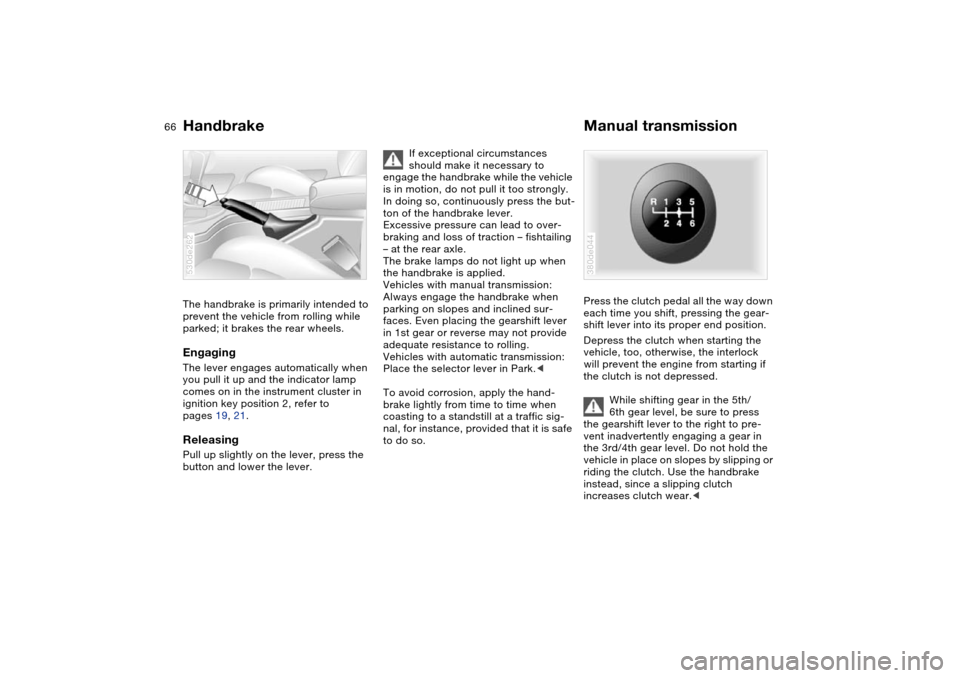
66n
Handbrake Manual transmissionThe handbrake is primarily intended to
prevent the vehicle from rolling while
parked; it brakes the rear wheels.EngagingThe lever engages automatically when
you pull it up and the indicator lamp
comes on in the instrument cluster in
ignition key position 2, refer to
pages 19, 21.Releasing Pull up slightly on the lever, press the
button and lower the lever. 530de262
If exceptional circumstances
should make it necessary to
engage the handbrake while the vehicle
is in motion, do not pull it too strongly.
In doing so, continuously press the but-
ton of the handbrake lever.
Excessive pressure can lead to over-
braking and loss of traction – fishtailing
– at the rear axle.
The brake lamps do not light up when
the handbrake is applied.
Vehicles with manual transmission:
Always engage the handbrake when
parking on slopes and inclined sur-
faces. Even placing the gearshift lever
in 1st gear or reverse may not provide
adequate resistance to rolling.
Vehicles with automatic transmission:
Place the selector lever in Park.<
To avoid corrosion, apply the hand-
brake lightly from time to time when
coasting to a standstill at a traffic sig-
nal, for instance, provided that it is safe
to do so.
Press the clutch pedal all the way down
each time you shift, pressing the gear-
shift lever into its proper end position.
Depress the clutch when starting the
vehicle, too, otherwise, the interlock
will prevent the engine from starting if
the clutch is not depressed.
While shifting gear in the 5th/
6th gear level, be sure to press
the gearshift lever to the right to pre-
vent inadvertently engaging a gear in
the 3rd/4th gear level. Do not hold the
vehicle in place on slopes by slipping or
riding the clutch. Use the handbrake
instead, since a slipping clutch
increases clutch wear.< 380de044
Page 69 of 200
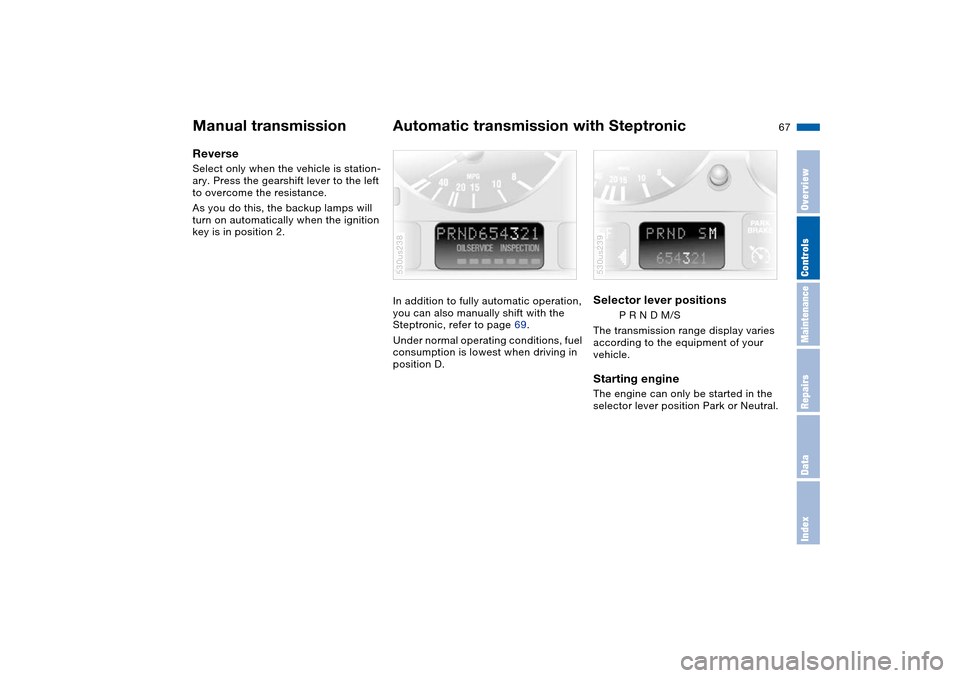
67n
OverviewControlsMaintenanceRepairsDataIndex
Manual transmission Automatic transmission with SteptronicReverse Select only when the vehicle is station-
ary. Press the gearshift lever to the left
to overcome the resistance.
As you do this, the backup lamps will
turn on automatically when the ignition
key is in position 2.
In addition to fully automatic operation,
you can also manually shift with the
Steptronic, refer to page 69.
Under normal operating conditions, fuel
consumption is lowest when driving in
position D.
530us238
Selector lever positions
P R N D M/S
The transmission range display varies
according to the equipment of your
vehicle.
Starting engine The engine can only be started in the
selector lever position Park or Neutral. 530us239
Page 70 of 200
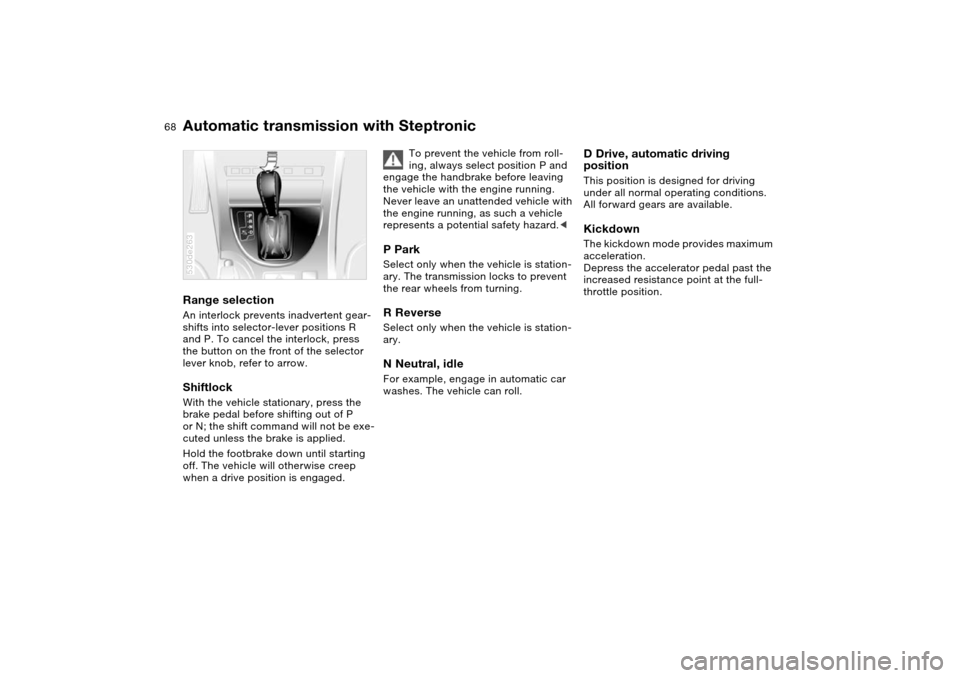
68n
Automatic transmission with SteptronicRange selection An interlock prevents inadvertent gear-
shifts into selector-lever positions R
and P. To cancel the interlock, press
the button on the front of the selector
lever knob, refer to arrow. ShiftlockWith the vehicle stationary, press the
brake pedal before shifting out of P
or N; the shift command will not be exe-
cuted unless the brake is applied.
Hold the footbrake down until starting
off. The vehicle will otherwise creep
when a drive position is engaged.530de263
To prevent the vehicle from roll-
ing, always select position P and
engage the handbrake before leaving
the vehicle with the engine running.
Never leave an unattended vehicle with
the engine running, as such a vehicle
represents a potential safety hazard.<
P Park Select only when the vehicle is station-
ary. The transmission locks to prevent
the rear wheels from turning.R Reverse Select only when the vehicle is station-
ary. N Neutral, idle For example, engage in automatic car
washes. The vehicle can roll.
D Drive, automatic driving
positionThis position is designed for driving
under all normal operating conditions.
All forward gears are available. Kickdown The kickdown mode provides maximum
acceleration.
Depress the accelerator pedal past the
increased resistance point at the full-
throttle position.